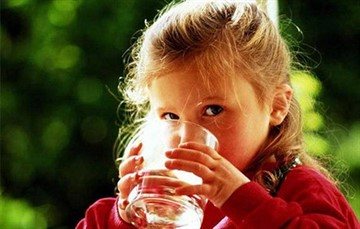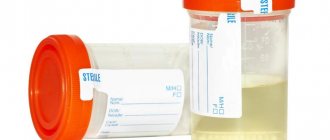Any deviations in the child’s tests alert parents. At an early age and in older children, with inflammatory processes in the urinary tract, such an unpleasant phenomenon as cloudy urine is observed.
In a child, the color of the excreted fluid may differ sharply from the usual state of urine. If on the previous day carrots or beets were not present in the menu, which gives the urine a reddish or orange tint, then you should definitely visit a urologist to find out the reason for the deviation.
Causes of cloudy urine in children
In most cases, the unusual color of the liquid in the pot after urination indicates negative processes in the body. When taking a test, doctors detect an increased number of leukocytes, protein, and red blood cells in the urine. Sometimes the problem occurs due to improper drinking regimen or consumption of certain foods.
The main causes of cloudy urine in children:
- cystitis (more often in girls);
- pyelonephritis;
- diabetes;
- parenchymal jaundice (urine not only becomes cloudy, but also darkens);
- dehydration due to uncontrollable vomiting, diarrhea, prolonged stay in a stuffy room or in the heat;
- diabetes;
- severe burns;
- poisoning;
- the child drank little liquid during the day;
- hypervitaminosis;
- use of potent drugs, especially antibiotics;
- excessive accumulation of salts: urates, oxalates, phosphates;
- inclusion in the menu of products with artificial colors, irritants that provoke diseases of the urinary system.
The healthy color of urine is light yellow, transparent, without impurities, sediment and blood. “Flakes”, sand, changes in the color of the liquid or cloudiness often develop when pathogenic microorganisms multiply in the urinary tract.
Find out what diffuse kidney changes mean and how to treat associated diseases.
How to treat a left kidney cyst? Effective treatment options are described in this article.
Cloudy urine in a child: causes and possible diseases
The answer to the question of why a child has cloudy urine is painful conditions when a violation of transparency is a symptom of a disease.
Possible diseases include:
- diabetes;
- diseases of the genitourinary system;
- liver pathologies;
- hypervitaminosis;
- viral and bacterial infections.
With natural causes, cloudy urine is not a symptom of a disease, but a sign of physiological processes occurring in the child’s body:
- in newborns, urine is often cloudy, this goes away after a couple of days;
- when introducing complementary foods to infants, urine may lose transparency for some time;
- Why does my child have cloudy urine in the morning? Morning urine, due to the lack of night urination, is always more concentrated compared to urine excreted at other times of the day, therefore it has an intense color and may become cloudy;
- Taking certain medications and vitamin complexes affects the color and clarity of urine. Information about such properties of drugs is indicated in the annotations to them;
- dehydration, a condition of the body in which the level of tissue saturation with fluid is insufficient.
The main causes of dehydration are violation of the drinking regime (the child drinks little) or increased fluid consumption:

- when visiting a sauna, hot weather, intense physical activity, a stressful situation;
- poor nutrition, when a child consumes foods and drinks with artificial colors, food additives (chips, crackers, pops, etc.). Excessive consumption of dairy, meat, plant products.
Mild dehydration cannot be treated; it is enough to give the child more water, preferably plain drinking water; sweet carbonated drinks will not satisfy the body’s needs.
Cloudy urine as a sign of pathology
This unpleasant phenomenon often develops against the background of other signs indicating the development of urinary tract pathology. Infectious diseases cause fever in children. Protein flakes are visible in the urine, sediment, mucus, and blood clots are present. Identification of additional symptoms indicates intoxication of the body, problems with the kidneys and bladder.
“What diseases can cause cloudy urine in a child?” This question is often asked to urologists by parents who are faced with an incomprehensible phenomenon.
To make a diagnosis and find out the cause of the deviation, it is important to examine the young patient, find out the drinking regime, diet, and pay attention to symptoms indicating the possible development of an inflammatory process. When diagnosing diseases by changes in the color and transparency of urine, the nephrologist must take into account other signs.
In infants, the organs of the urinary system are not yet functioning at full capacity; a temporary change in the shade of urine is possible while the tiny organism adapts to life. Sometimes the problem appears when introducing new foods into the diet.
Important! Often, parents themselves provoke negative processes in the baby’s body by offering the child inappropriate products that the child persistently demands (sweet carbonated drinks, Chupa Chups with dyes, sweets with flavors). An excess of meat products on the menu provokes the accumulation of urates and increases the risk of relapse of allergic diseases.
Characteristic changes in urine status:
- light red tint – development of glomerulonephritis, injury to the lining of the bladder;
- fine sand is clearly visible at the bottom of the container with urine - the development of urolithiasis;
- dark yellow, cloudy urine – dehydration, severe burn, hydronephrosis;
- greenish-yellow tint – hepatitis;
- cloudy urine with flakes, pus, white sediment - there is a high probability of developing kidney inflammation - pyelonephritis.
Basic diagnostic methods:
- general urine analysis;
- Ultrasound of the kidneys;
- blood chemistry;
- urine analysis according to Zimnitsky and Nechiporenko;
- urine culture to identify infectious agents;
- ultrasound examination of the bladder;
- urography of the bladder.
Pathologies that lead to changes in the color of urine and accompanying symptoms
In a child, cloudy urine with sediment may appear as a result of the penetration of pathogenic microflora (fungi, viruses, bacteria) into the organs of the urinary system. In this case, the following types of pathological processes can be diagnosed:
- Pyelonephritis. An acute nonspecific process of inflammation localized in the kidney tissue. In addition to the color change, the child develops cloudy urine with an unpleasant odor from the first days of the onset of the disease. This disease is especially acute in the first years of a child’s life. An additional symptom is a high body temperature, which can cause convulsive symptoms. In addition, stool upset occurs, the skin acquires a bluish tint, nausea occurs, followed by the appearance of a gag reflex.
- Urethritis. With this disease, damage occurs to the mucous epithelium that lines the inner surface of the urethra. This disease in children causes a violent clinical picture in which: urine loses its transparency, and its excretion is accompanied by pain and the presence of purulent discharge; sometimes blood may appear after emptying the bladder; urination becomes more frequent, and urine output decreases; The child is often capricious and cries, which disrupts night sleep.
- Cystitis. This inflammatory process affects the walls of the bladder. Most often it manifests itself as a consequence of complications of urethritis or pyelonephritis. The child complains of frequent or, conversely, rare urges for small needs, and his urine has a foul odor and is dark yellow in color. The temperature can rise to critical levels (38-39 degrees), which is why small patients begin to be capricious, they become irritable and lack sleep at night.
- Acetonemic syndrome. This condition occurs in various diseases that cause an increase in the synthesis of ketone bodies, and as a result, they do not have time to be utilized in the child’s body. In this case, the discharge will smell like acetone. In addition, young patients experience pallor of the skin, and an unhealthy blush appears on the face. Weakness and a feeling of constant malaise can occur against the background of a pronounced gag reflex, which occurs after eating any type of food.
- Diabetes disease. Urine excretion, with the development of this pathology, has a persistent odor of acetone, sometimes with a sickly sweetish tint. The occurrence of a pathological process of the first type can subsequently cause slowly healing wounds and cause sudden loss of consciousness due to an increase or decrease in the level of glucose in the systemic bloodstream.
Symptoms and treatment
The main signs accompanying urinary tract infections:
- cloudy urine;
- discomfort in the lower abdomen, lumbar region;
- pain during urination;
- temperature increase;
- fever, chills;
- foreign impurities appear in the urine: blood, sediment, “flakes”, pus;
- the whites of the eyes and skin tone change from the usual to yellow;
- urine acquires an unpleasant odor;
- the child is restless, whiny;
- appetite decreases, sleep deteriorates;
- vomiting develops;
- bowel dysfunction (diarrhea);
- weakness appears, the child is lethargic.
Recommendations for restoring urine quality in the absence of bacterial infection:
- it is enough to normalize the drinking regime;
- you will have to change your diet (give up processed foods, sweet soda, items with preservatives and dyes);
- an important point is the use of vitamin-mineral complexes according to the norms for a certain age;
- If cloudy urine occurs while taking antibiotics, then at the end of the course of therapy it is important to take probiotics and drink enough fluid to remove excess accumulated drugs from the body.
Therapy for pathological processes depends on the diagnosis made by a nephrologist or urologist. During treatment, advice from an experienced pediatrician and gastroenterologist is important if a urinary tract infection has developed due to the penetration of E. coli, opportunistic bacteria inhabiting the gastrointestinal tract.
Find out what nocturia is in women, the symptoms and treatment of the disease.
The reasons for the formation of kidney stones and the elimination of provoking factors are written in this article.
Go here to read about the prognosis after kidney cancer removal in women.
The main groups of drugs for stopping the inflammatory process:
- antibiotics. Ampiox, Carbenicillin, Ampicillin, and drugs from the cephalosporin group are suitable for children. At an early age, potent compounds - aminoglycosides - are not prescribed;
- diuretics (diuretic drugs). Furosemide, Diacarb, Hypothiazide, Veroshpiron. Natural diuretics: watermelon, cranberry juice, lingonberry leaf tea, dill water;
- general strengthening compounds, vitamin and mineral complexes;
- preparations that dissolve salts. Canephron (dragées from 6 years), Blemaren (from 12 years), Urolesan (syrup - from 1 year, capsules and drops - from 7 years);
- antispasmodics. Fennel fruit oil, dill water, M-anticholinergic agent priphinia bromide, mint tea, Platiphylline;
- analgesics. Paracetamol, Panadol, Ibuprofen, Nurofen.
Diagnosis of diseases by urine analysis
Dark yellow, opaque urine is observed with burns, dehydration, and hydronephrosis. White flakes with pus should alert you and indicate acute inflammatory processes in the kidneys, pyelonephritis. Urine becomes light red with damage to the bladder, infections in it, glomerulonephritis, yellow-green - with hepatitis. Urine will turn pink due to an increase in red blood cells in cases of cystitis, urolithiasis, and oncology.
The exact cause can only be determined by analysis. The following types of urine tests are performed in laboratory conditions:
- General clinical analysis. The physical and chemical characteristics of the substance and the components of the sediment are studied.
- Tests according to Nichiporenko. They make it possible to count the formed components of urine in 1 ml.
- Analysis using Zimnitsky's method. The relative density of urine is determined to determine the child’s body’s ability to concentrate it.
A laboratory test of urine analysis will help determine the causes of cloudiness.
In addition, to get a complete picture of the pathology, the doctor prescribes an ultrasound of the urinary system and a biochemical blood test. Its purpose is to evaluate renal and hepatic function.
Useful tips
How to prevent cloudy urine in a child? Doctors recommend studying the list of factors that provoke negative processes in the kidneys and bladder.
Preventive measures:
- drinking clean water according to the norms for a certain age;
- proper nutrition, avoidance of harmful products containing synthetic dyes;
- reasonable consumption of meat dishes, sour fruits, sorrel. Drinking milk with a high percentage of fat content is not beneficial;
- the child’s diet should be appropriate for his age;
- careful hygiene of the external genitalia, especially in girls;
- refusal to swim in polluted waters;
- taking antibiotics only as prescribed by a pediatrician or specialist; after the course, using drugs with lactobacilli to restore intestinal microflora;
- prevention of hypothermia;
- treatment of inflammatory diseases: through lymph and blood, harmful bacteria spread throughout the body, penetrate the bladder, kidneys;
- timely visits to doctors if there is a change in the child’s behavior, the appearance of weakness, chills, or a change in the color of urine. It is important to notice signs of intoxication in time and prevent the spread of infection.
When the urine becomes cloudy in children, you should not panic, but rather understand the reasons for the deviation. It is important to remember what the child ate and drank the day before, what medications he took, and whether he suffered an infectious disease. All parents’ questions will be answered by a urologist or nephrologist, with whom you should make an appointment. If additional signs are observed that confirm the development of a pathological process in the body, then you should not postpone a visit to a specialist: pathologies of the bladder and kidneys in advanced stages are difficult to treat, and relapses are possible.
Children's doctor Komarovsky will talk about urine analysis and the features of treating urinary tract infections in the following video:
Watch the video film “A child’s urine is like water”:
Diabetes can also cause these changes in urine color. In this case, the change in the color of the child’s urine will be provoked by the body’s attempt to remove excess glucose from the body using the urinary system. In this case, the child will drink a lot of water and go to the toilet often.
Kidney failure is also a cause of discolored urine. However, in this case, the color changes due to impaired kidney function, in which case the body may not receive enough fluid, which may cause dehydration in the child.
If diuretics were used in a child during the treatment of any disease, then it is not surprising that the color of the urine has changed to a lighter color.
It is necessary to show the child to the doctor if the color of the urine has changed very much and has become pale, transparent, almost like water. Also if the child’s need for water has increased for no apparent reason. Children who have these symptoms should be seen by a doctor immediately, as they may be the result of a serious illness. In this case, it is better to start treatment as quickly as possible.










